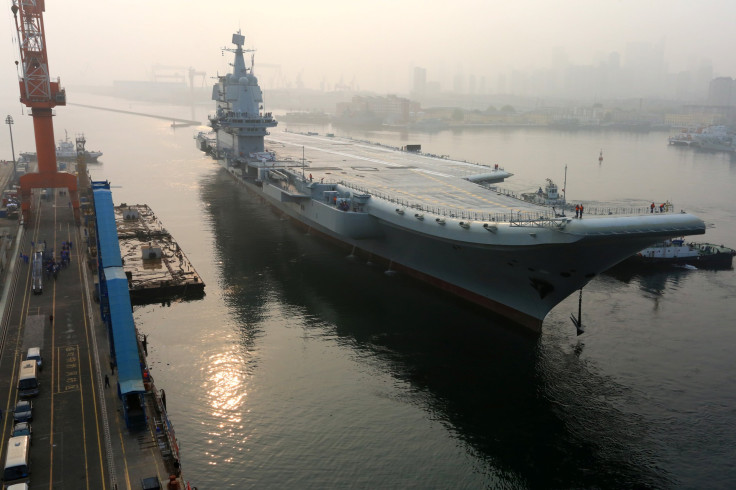Chinese Navy Building 'Super Carrier' As Its Second Aircraft Carrier Shandong Completes Sea Trials
KEY POINTS
- Catapult on China's third carrier, Type 003, will allow its planes to carry more fuel and weapons
- Shandong, the PLA Navy's second aircraft carrier, recently completed its third sea trials
- China currently has one fully operational aircraft carrier -- the Liaoning
As Shandong, China's first home-built aircraft carrier completes its 23-day sea trials, reports say the PLA Navy's newest carrier, its third, will be even more advanced than the previous ones and come with CATOBAR (catapult-assisted take off but arrested recovery) equipment.
The catapult system will allow the warplanes on board the Type 003, as the new carrier is designated to launch with higher payloads, said a report by The Eurasian Times. It is not clear if the catapult is steam-operated or electromagnetic. The latter is a more advanced technology and only the U.S. Navy's Gerald R. Ford is known to be equipped with one.
But a Chinese carrier equipped with any type of a launch catapult will cause a big change in the dynamics of naval power projection. The launch catapult is a specialty of the U.S. Navy, with the French aircraft carrier Charles de Gaulle being the only warship outside of the U.S. Navy to be equipped with such a system.
The catapult on Type 003 will enable the J-15 fighter aircraft it carries to fly with more fuel and weapons, than if launched from one of China's other two carriers, the Liaoning and the Shandong. These two ships use a Short Takeoff Barrier Arrested Recovery (STOBAR) system, which relies on the aircraft’s own propulsion and have ramps on the bow to assist during take-off. This system limits the fighting capabilities of the aircraft.
Recent viral images of the J-15T, a new variant of the J-15, showed modifications required to operate from catapult-equipped carriers. The aircraft is about three tons heavier than its American counterpart, the F-18 Hornet.
The J-15 does not stand much of a chance against the F/A-18, but that may change once the Type 003 and other "super-carriers" with catapults get operational, the Business Insider said in a report.
The Chinese Communist Party-backed Global Times calls the Type 003 a "super-carrier," with a full displacement of more than 80,000 tons. The Liaoning and Shandong displace about 60,000-tons each and are considered medium-sized carriers. Still, the Type 003 pales in comparison with one of the Nimitz class carriers operated by the U.S. Navy — they weigh about 100,000 to 104,600 tons per piece.
China currently has only one fully-operational aircraft carrier, the Liaoning (Type-001), in addition to the Shandong. The third aircraft carrier has not been named yet and is a completely different design from the former two.
Meanwhile, the Shandong, which was commissioned in December last year by President Xi Jinping, has completed its third sea trials.
The South China Morning Post (SCMP) reported that Shandong finished a 23-day voyage in the Bohai Sea and returned to its homeport of Dalian in the northeast province of Liaoning on Sunday.
While sources told SCMP that the vessel was expected to reach initial operational capability as early as the start of next year, the pandemic seems to have affected its combat readiness.
"The pandemic had dragged out training schedules, with the crew forced to spend more time on pandemic-control measures. All sailors should be quarantined for two weeks before boarding the ship. Another three weeks will be spent in isolation after their return,” the report said quoting an insider.
According to Hong Kong-based pro-Beijing newspaper Wen Wei Po, satellite images showed a submarine sailing near the Shandong during the trials. This could be part of the training to improve the carrier’s ability to give cover to the country’s nuclear-armed ballistic submarines.
However, Lu Li-shih, a former instructor at Taiwan’s Naval Academy in Kaohsiung, said the presence of a nuclear submarine might be a signal to the U.S. on China's nuclear strength, as per the report.

© Copyright IBTimes 2024. All rights reserved.





















